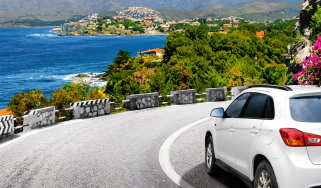What is Crit’Air? The French clean air sticker and whether your car needs one
Introduced in 2017, Crit’Air stickers are used to show French officials how polluting (or not) your car is – and are essential for UK motorists
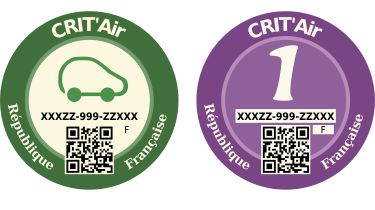
For years it’s been common knowledge that, to drive your car in Europe, you need to display a ‘UK’ (previously ‘GB’) sticker on the back of your car so authorities can easily identify you as a foreign driver.
Now, drivers travelling to France need to contend with another sticker which, rather than marking you out as an international visitor, has the purpose of identifying your vehicle’s emissions levels.
The sticker comes as part of France’s Crit’Air programme, which has been designed to improve air quality in cities by limiting access to the most polluting of vehicles.
Sounds complicated? It is rather.
With this in mind, we’ve compiled a guide to answer all the key questions you might have about this topic. And if you’re looking for further guidance when getting behind the wheel on your vacation, we have an additional page dedicated to tips for driving abroad, as well as a full breakdown on holiday car hire.

What is a Crit’Air sticker?
A Crit’Air sticker, also known as a ‘vignette’, is an identifier used in France to help authorities ascertain the emissions level of your particular vehicle.
It is intended to be affixed to the inside windscreen of your car, much like an old-fashioned tax disc, and lasts for the entire lifetime of the vehicle.
There are six levels of Crit’Air sticker, with each incremental step representing a specific group of vehicles, ranging from the greenest and cleanest to the most polluting, based on its Euro emissions standard:
Crit'Air sticker levels
- Crit’Air 0/E (Green) – ZEVs (electric and hydrogen vehicles)
- Crit’Air 1 (Violet) – Plug-in hybrids (PHEVs), Euro 5/6 petrol vehicles
- Crit’Air 2 (Yellow) – Euro 4 petrol vehicles, Euro 5/6 diesel vehicles
- Crit’Air 3 (Orange) – Euro 2/3 petrol vehicles, Euro 4 diesel vehicles
- Crit’Air 4 (Red) – Euro 3 diesel vehicles
- Crit’Air 5 (Grey) – Euro 2 diesel vehicles
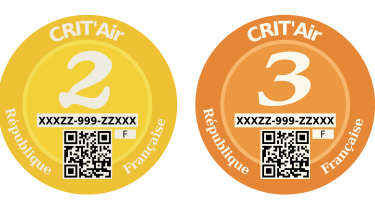
Why has Crit’Air been introduced?
Developed and implemented in 2017 by the French Ministry of the Environment, the Crit’Air scheme was designed to reduce pollution levels in the nation’s largest towns and cities. A significant proportion of France’s city-dwelling population live in areas that exceed European standards for air quality, putting their health at risk.
With the Crit’Air system, the most polluting of vehicles can be banned from driving in certain areas – either on a permanent basis, or when air quality levels are poor – with stickers being used to identify those entering places they shouldn’t.
Where in France requires a Crit’Air sticker?
When driving in France, you need to be aware of the several types of low-emissions zones that require you to display a Crit’Air sticker: ZCRs, ZPAs and the Paris Crit’Air zone.
ZCRs are your standard low-emissions zones and can be found all across the country, in places including:
Fixed Crit’Air zones in France | |
| Aix-Marseille-Provence | Marseille |
| Bordeaux | Montpellier |
| Clermont-Ferrand | Paris |
| Grenoble | Reims |
| Lille | Rouen |
| Lyon | Strasbourg |
| Nice | Saint-Etienne |
Then there are ZPAs which are essentially emergency low-emissions zones which can be set up whenever there are high levels of pollution in a particular area. These include:
Temporary Crit’Air zones in France | |
| Annecy | Lille |
| Chambery | Loiret/Orléans |
| Arve Valley | Lyon |
| Côte d’Or/Dijon | Maine-et-Loire |
| Creuse/Guéret | Marseille |
| Deux-Sèvres/Niort | Paris |
| Drôme/Valence | Puy-de-Dome/Clermont Ferrand |
| Eure-et-Loir/Chartres | Pyrénées-Atlantiques |
| Gers/Auch | Rennes |
| Gironde/Bordeaux | Savoie/Chambery |
| Grenoble | Strasbourg |
| Haute-Savoie/Annecy | Toulouse |
| Hérault/Montpelier | Vendée/La Rouche-sur-Yon |
| Isère/Grenoble | Vienne/Poitiers |
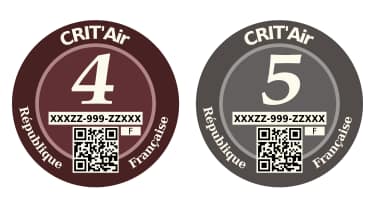
Paris Crit’Air zone rules
Finally, there’s the Paris Crit’Air zone which, confusingly, encompasses two separate zones: Central Paris ZCR and Greater Paris ZCR.
The Central Paris ZCR was introduced back in 2015 as France’s first low-emissions zone. This extends all the way out until the Boulevard Périphérique ring road, which encircles the inner-most sector of the capital.
The Greater Paris ZCR, on the other hand, came into effect in 2019 and stretches all the way out to the A86 outer ring road.
Since 2024, no diesel cars have been allowed in the Central Paris ZCR, nor the Greater Paris ZCR, and only cars using vignettes rated from Crit’Air 0/E or 1 can enter between 8am and 8pm from Monday to Friday.
A zero-emissions zone, meaning only electric and hydrogen cars are allowed (in other words, those with a Crit’Air 0/E sticker), is planned to come into effect in 2030. Other ZCRs will also almost certainly spring up across the country in the coming months and years.
How do I know if I’m in a low-emissions zone in France?
If you’re wondering whether you’ve entered a ZCR or ZPA in France, you should see a sign with a red circle to establish that the zone has come into force. You’ll then see another with a grey circle to notify you that it’s ended.
Can I drive a car in France without a Crit’Air sticker?
Driving without a Crit’Air vignette in France is not a good idea, as this will leave you liable to receiving a fine of €68 (roughly £58 at the time of writing) if you cross through any of the low-emissions zones; this can be reduced to €45 (£38) if paid promptly, or increased to €180 (£153) if not paid within 60 days.
Do I need a Crit’Air sticker for Spain or any other country?
The Crit’Air scheme only applies to France, which means you don’t need one to drive in the likes of Spain, Germany, Belgium or any other European country. That said, if you’re driving through a low-emissions zone in France to reach any other country as your final destination, you will need to have a vignette affixed to your windshield.
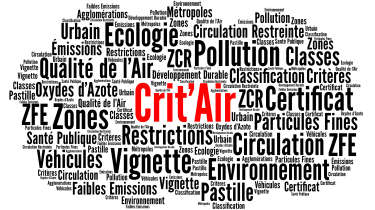
Do all cars need Crit’Air stickers?
Almost all cars being driven in France require a valid Crit’Air sticker. However, those registered before January 1997, plus motorbikes and scooters registered before June 2000, don’t qualify and are thus banned from entering low-emission zones.
How much is a Crit’Air sticker?
Buying a Crit’Air sticker will set you back €3.81 (£3.20), although adding international postage will increase this to €4.76 (£4).
Where can I buy a Crit’Air sticker?
The only place we recommend you buy your Crit’Air sticker is via the official government website; make sure you do so early, as it can take up to six weeks to arrive.
Be aware that there are several scam sites that will sell you a vignette for vastly inflated prices; just a quick Google search revealed some shady firms selling them for as much as £20. There is no guarantee these could be genuine, which means not only are you wasting your money, you may also receive a fine once in France.
How long does a Crit'Air sticker last?
Pay the fee to buy a Crit’Air sticker and, as mentioned above, it will last the entire lifetime of the vehicle. This is, of course, unless the vehicle undergoes major changes or modifications, or if the sticker for some reason becomes illegible.
For more tips on driving in France check out our complete guide...
Find a car with the experts


